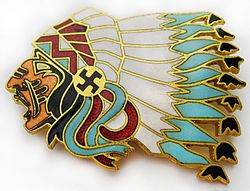Lafayette Escadrille
| Escadrille 124 | |
|---|---|

Squadron Insignia of the Lafayette Escadrille
|
|
| Active | 1916 |
| Branch |
|
| Type | Fighter Squadron |
| Engagements |
World War I |
The Lafayette Escadrille (French: Escadrille de Lafayette) was an escadrille of the French Air Service, the Aéronautique Militaire, during World War I composed largely of American volunteer pilots flying fighters. It was named in honor of the Marquis de Lafayette, hero of the American and French revolutions.
Dr. Edmund L. Gros, a founder of the American Hospital of Paris and organizer of the American Ambulance Field Service, and Norman Prince, an American expatriate already flying for France, led the efforts to persuade the French government of the value of a volunteer American air unit fighting for France. The aim was to have their efforts recognized by the American public and thus, it was hoped, the resulting publicity would rouse interest in abandoning neutrality and joining the fight. Authorized by the French Air Department on March 21, 1916, the Escadrille Américaine (Escadrille N.124) was deployed on April 20 in Luxeuil-les-Bains, France.
Not all American pilots were in Lafayette Escadrille; other American pilots fought for France as part of the Lafayette Flying Corps.
The squadron was then moved closer to the front to Bar-le-Duc. A German objection filed with the U.S. government, over the actions of a supposed neutral nation, led to the name change to Lafayette Escadrille in December 1916, as the original name implied that the U.S. was allied to France rather than neutral.
The unit's aircraft, mechanics, and uniforms were French, as was the commander, Captain Georges Thénault. Five French pilots were also on the roster, serving at various times. Raoul Lufbery, a French-born American citizen, became the squadron's first, and ultimately their highest scoring flying ace with 16 confirmed victories before the pilots of the squadron were inducted into the U.S. Air Service.
...
Wikipedia
